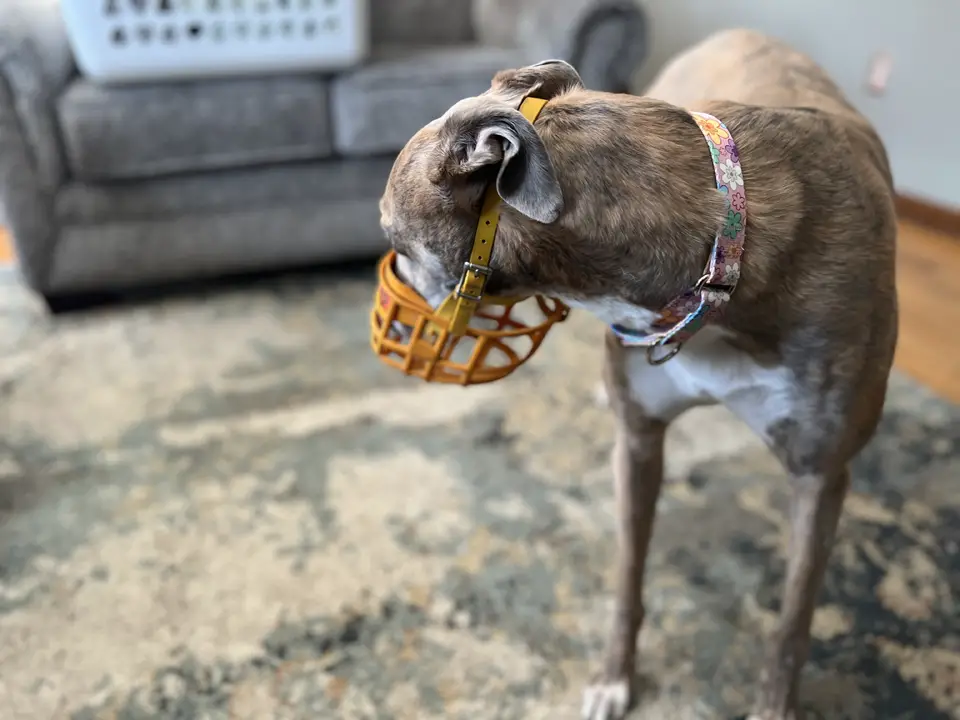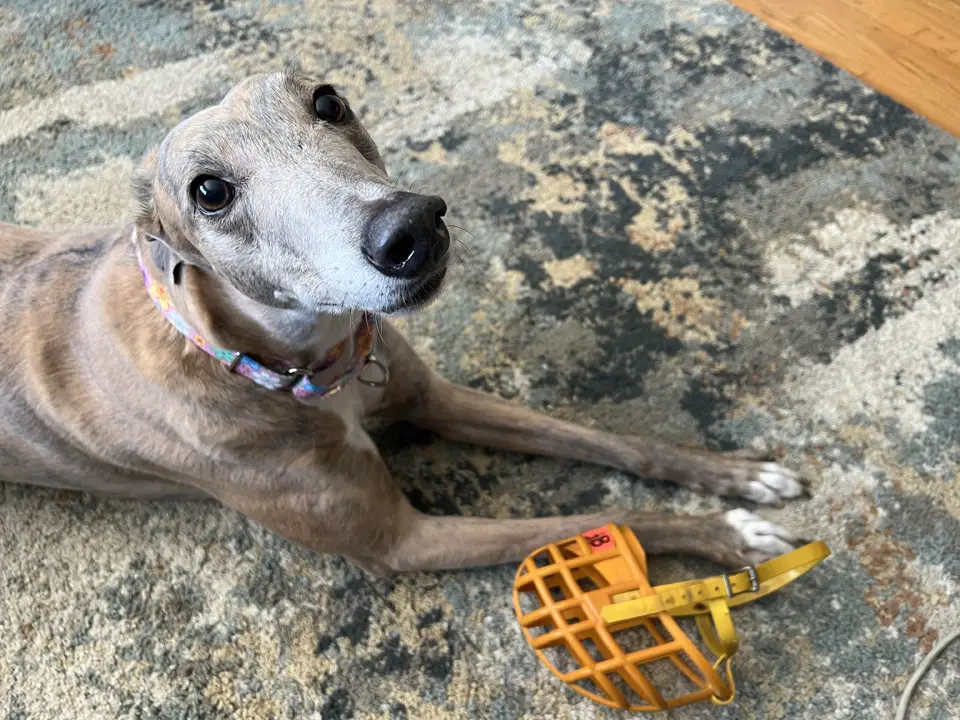When I first got my Greyhounds Brittany and Gill, we were provided muzzles from the rescue. It seemed a bit odd to give me that at first because I was concerned there were problems. But it ended up not being a problem at all.
When we see Greyhounds wearing muzzles, it might spark curiosity or concern. It’s important to understand that the use of muzzles is a standard practice in the Greyhound racing world as well as among Greyhound owners.
The primary reason Greyhounds are muzzled during races is for the safety of all the dogs involved. These highly athletic dogs are competitive and can become overstimulated during a race. When this happens, their instinctive chase drive can lead to accidental nipping or more severe altercations with other Greyhounds on the track.
If you want a close up video of why this is so important during Grehound races, here’s a perfect example…..
Furthermore, Greyhounds are often muzzled while in public or with other animals to ensure they don’t harm wildlife or smaller pets they may perceive as prey. Despite the appearance of muzzles, these dogs are not typically aggressive and the muzzles are normally just a precaution to manage their prey-driven behaviors.
It’s a common misconception that muzzles signify an aggressive dog. However, in the case of Greyhounds, wearing muzzles is more about their high prey drive and the tremendous excitement they experience during races.
Muzzles are similarly used in domestic settings with retired racing Greyhounds to prevent accidents and ensure a smooth transition into a pet lifestyle, where they may encounter many different animals and situations.
Table of Contents
Origins of Muzzling Greyhounds
Let’s explore the historical reasons behind the practice of muzzling Greyhounds and how breed-specific behaviors have perpetuated this tradition.
Historical Context
The practice of muzzling Greyhounds can be traced back to their origins as sighthounds, a group known for their keen vision and high-speed hunting.
Prehistoric use of these dogs for hunting relied on their strong prey drive and swift hunting technique.
By the Middle Ages, European nobility had embraced the practice for more organized forms of hunting, such as hare coursing, where Greyhounds pursued hares, foxes, and deer with lethal precision.
Muzzling was introduced as a means of protecting the dogs from harm during these high-speed chases and preventing premature capture of the prey.
Breed-Specific Behavior
Greyhounds, like all sighthounds, possess an instinctual prey instinct that can be triggered during high-adrenaline activities such as racing or coursing. Given their speed and potential to react quickly to moving objects, the Greyhound racing community adopted muzzling to maintain safety among racing dogs. This ensures that in the heat of a race, when the dogs’ prey drive is at its peak, the risk of injury from aggressive behavior is minimized.
Luckily our Brittany is as far from aggressive as you can get. She’s so cute and took this nice picture for me, after I took her muzzle off of course!
Our understanding of these practices reflects a commitment to the welfare of Greyhounds, acknowledging both their hunting heritage and the requirements of modern racing environments.
Understanding Greyhound Muzzles
In the world of Greyhound racing and ownership, muzzles are a common accessory. We’ll explore the specific types of muzzles used and how their design prioritizes the comfort of these agile dogs.
Types of Muzzles
- Basket Muzzles: The primary type of muzzle used for Greyhounds is the basket muzzle. Its design allows for ample space for the dog to pant and drink water, ensuring comfort during wear. Basket muzzles are made from a variety of materials, including lightweight plastic, which provides a balance between durability and comfort for the dog.
- Fabric Muzzles: These are less common and not typically preferred for Greyhounds due to their limited space for panting, which is essential for a Greyhound’s thermoregulation, especially after a race.
Greyhounds do not typically wear “ear muzzles” as this term does not correspond to a commonly used type of muzzle. Instead, their muzzles cover the mouth and allow for ear movement.
As you can see, our Brittany is wearing the more common Basket Muzzle in her pictures. She’s not too fond of wearing it, but she I told her should could have some cheese if she modeled it for us. She was happy (sort of) to do so!
Design and Comfort
- Lightweight Construction: We emphasize lightweight materials in Greyhound muzzle design. This minimizes any additional burden on the dog, allowing them to run without noticeable weight on their heads.
- Space for Panting: A good Greyhound muzzle will always provide ample space for the animal to pant freely. Panting is a dog’s primary means of cooling down, especially after a race or during high activity.
- Adjustability: To ensure proper fit, Greyhound muzzles are designed with adjustable straps. This reduces the risk of chafing and ensures the muzzle is not too tight or too loose.
Basket muzzles should not be confused with the “cone” or Elizabethan collar, which is a device fitted around a dog’s neck to prevent them from licking or biting wounds. Muzzles, in contrast, are focused on preventing biting during close interactions with other dogs or humans and to ensure safety during high-energy situations such as racing.
Greyhound Racing and Muzzling
In our exploration of the Greyhound racing world, it becomes evident that muzzling is a key aspect of race safety protocols and the typical behavior of racing Greyhounds.
Race Safety Protocols
Muzzles are a mandatory part of the Greyhound race attire. This practice ensures the safety of the dogs and prevents biting incidents which may occur due to the high arousal levels experienced by racing Greyhounds.
During a race, a muzzle acts as a preventive measure against potential aggressive reactions amongst the racing dogs, especially in the highly charged atmosphere of a competitive event. Moreover, the close finishes of races, sometimes requiring a photo finish, can lead to situations where dogs are bunched together, increasing the risk of snapping or biting.
Racing Greyhounds’ Behavior
The behavior of racing Greyhounds is shaped by their strong instinctual drives. When these dogs are racing, their high prey drive can come to the fore, signaled by their intense focus and pursuit of the lure.
Although these dogs are trained and socialized, the race environment is intense, creating a situation where safety risks are managed through the use of muzzles. This ensures that any incidents or issues among the racing dogs can be effectively controlled, thereby safeguarding the wellbeing of the Greyhounds and maintaining the integrity of the sport.
Muzzles in Public Perception
Brittany doesn’t like to be in the public eye as you can see below. But muzzles are often a touchy subject when it comes to the dog loving public.
When discussing Greyhounds, it’s essential to address how muzzles affect public perception of the breed. Misunderstandings about muzzle use can lead to negative views regarding Greyhounds, while legislation and enforcement can influence these opinions.
Misconceptions and Reality
Many in the public often mistake the sight of a muzzled Greyhound as a sign of aggression or dangerous behavior. We see this misconception stem from a lack of knowledge about the breed’s behavior and the reasons behind muzzle use.
In truth, muzzles are precautionary tools during racing to prevent injuries arising from the dogs’ high arousal and close contact at high speeds. Additionally, it’s important to highlight that Greyhounds commonly display a high prey drive, and muzzles are used to prevent potential incidents with smaller animals.
Mandatory Muzzling Requirements often contribute to these negative perceptions. However, we must clarify that these requirements mainly concern safety during the excitement of a race or to comply with breed-specific legislation within certain local jurisdictions.
Brittany doesn’t like anything that’s ‘mandatory’ but in this case she still wants to sort of show you her muzzle and how it looks on her. She knew she was getting a treat after this, but she was still shy. 🙂
Legislation and Enforcement
Muzzling laws and breed-specific legislation can play a significant role in shaping public perceptions. Such laws are often enacted at the local jurisdiction level and can vary widely, thereby influencing whether or not people view muzzles as necessary or indicative of a breed’s temperament.
It is our responsibility to understand and convey that these regulations are not necessarily reflective of a Greyhound’s nature, but rather measures taken for the safety and well-being of the animals and those around them.
In some areas, greyhounds must be muzzled in public by law, something that can reinforce the belief that they are inherently aggressive. We must communicate the fact that these local laws are primarily in place to address concerns about dog races without unfairly stigmatizing the breed.
Through education on muzzling laws and their intentions, we can combat these misconceptions and work towards a more accurate understanding of Greyhounds in the public eye.
International Perspectives on Muzzling
Muzzling Greyhounds is a practice with varied regulations and perceptions across the globe. We observe international norms to protect the safety of the dogs and others.
Australia and Coursing
Australia has a historical connection to Greyhound racing and coursing, where the practice of muzzling Greyhounds began as a necessity. The use of muzzles during coursing events seeks to prevent injury to the dogs and the mechanical lure they chase. With animal welfare in mind, certain regions in Australia have reviewed their muzzling laws, leading to changes where muzzles are no longer mandatory for pet Greyhounds in some public spaces.
Global Muzzling Practices
Globally, muzzling Greyhounds, especially in racing scenarios, aligns primarily with safety concerns. Countries vary in their approaches, with places like Northern Ireland having banned coursing altogether, yet muzzling for racing dogs remains an international standard.
The primary reasons for these practices are to prevent bite-related injuries amongst the dogs during high-stimulation activities and to address any potential concerns from the public regarding dog behaviour. Despite differing regional regulations, the underlying intent is consistent: ensuring the wellbeing of Greyhounds and the safety of their companions and spectators.
Some Final Thoughts on Why Greyhounds Sleep So Much
I think there are plenty of reasons why you would want to have a muzzle for your Greyhound. Because our Brittany is an only-dog, we don’t normally need her to wear it and it’s only brought out for special occasions.
Normally that special occasion is when we bring her to the vet for a check up. I don’t make her wear it, but it’s nice to have it just in case.
As you get to know your Greyhound you’ll probably find times when it’s best to have them wear one. It’s nice to have it just in case you’re worried about your Grey snipping at another dog or animal.
I hope this helped. If you have any questions about your Greyhound’s muzzle related issues and you want to run them by me, please don’t hesitate to reach out. I’m always happy to help. Take care!








